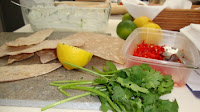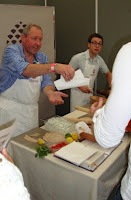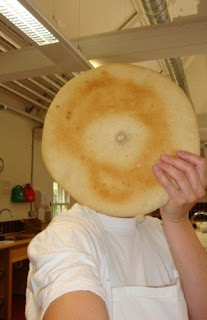There is a market out there for gluten-free products, but is it being served ? In my opinion, wheat intolerant or coeliac disease sufferers have every right to enjoy freshly baked breads, cakes and pastries. According to Coeliac UK, 1 in 100 people suffer from the disease, which can cause great discomfort and quite a list of more serious symptoms. So why are freshly baked gluten free products so hard to find? I am not sure I know the answer to this, I could hazard a guess that gluten-free is seen as an area of baking that is too niche to cater for, expensive to produce due to the variety of alternative flours needed and perhaps there is not the inclination to create a variety of gluten free products because it is an unknown area.
Why should coeliac sufferers miss out on all the yummy goods most of us can access without any painful side effects? This week’s baking with Emmanuel Hadjiandreou (his book is out soon!) proved that we could offer some tasty gluten-free alternatives, and dare I say it, our chief tasters couldn’t even tell the difference!
 Just to clarify, true gluten-free means NO wheat flour, NO rye flour and NO spelt flour. For the baked goods below we used; Plain gluten-free flour from Doves Farm, Buckwheat Flour, Potato flour, Maize flour, Rice flour and Chickpea flour (aka Gram flour). All these flours are related to wheat flour as sub-species in some form but they do not contain gluten (large protein molecules) that exist in wheat flour. Gluten provides the elasticity in the dough and supports the crumb structure so you get a chewy, aerated and well risen loaf. In gluten-free bread this is substituted with other carbohydrates or starches that develop long chains to link the structure together eg. Xanthum gum, which is a type of starch produced by fermentation and improves the texture when combined with gluten-free flour.
Just to clarify, true gluten-free means NO wheat flour, NO rye flour and NO spelt flour. For the baked goods below we used; Plain gluten-free flour from Doves Farm, Buckwheat Flour, Potato flour, Maize flour, Rice flour and Chickpea flour (aka Gram flour). All these flours are related to wheat flour as sub-species in some form but they do not contain gluten (large protein molecules) that exist in wheat flour. Gluten provides the elasticity in the dough and supports the crumb structure so you get a chewy, aerated and well risen loaf. In gluten-free bread this is substituted with other carbohydrates or starches that develop long chains to link the structure together eg. Xanthum gum, which is a type of starch produced by fermentation and improves the texture when combined with gluten-free flour. For info; Khoresan (aka Kamut) DOES contain gluten so not suitable for Coeliac sufferers.
When baking gluten free products, the important things to consider are:
1) Ingredients (balancing the flavours of the gluten-free flours that you use)
2) When mixing your dough for bread making, you are looking for a much wetter, almost batter like consistency.
3) Be creative. Enrich your doughs to improve flavour with seeds, fruit and spices.
4) Trial your gluten free products with coeliac sufferers. Ask them what they think and how you might improve them.
 |
| Fruit spiced, seeded & buckwheat |
 |
| Mini tarts filled with real jams & mini bakewell tarts. |
 |
| Seeded sourdough (overnight long fermentation) |
 |
| Pear & ginger frangipane tart (with ground chestnut) |
 |
| Chewy chocolate chip cookies |
 |
| Deluxe chocolate cookies with dark chocolate &coffee topped with hazelnut, cherry & almonds (with thanks to Russell) |





































